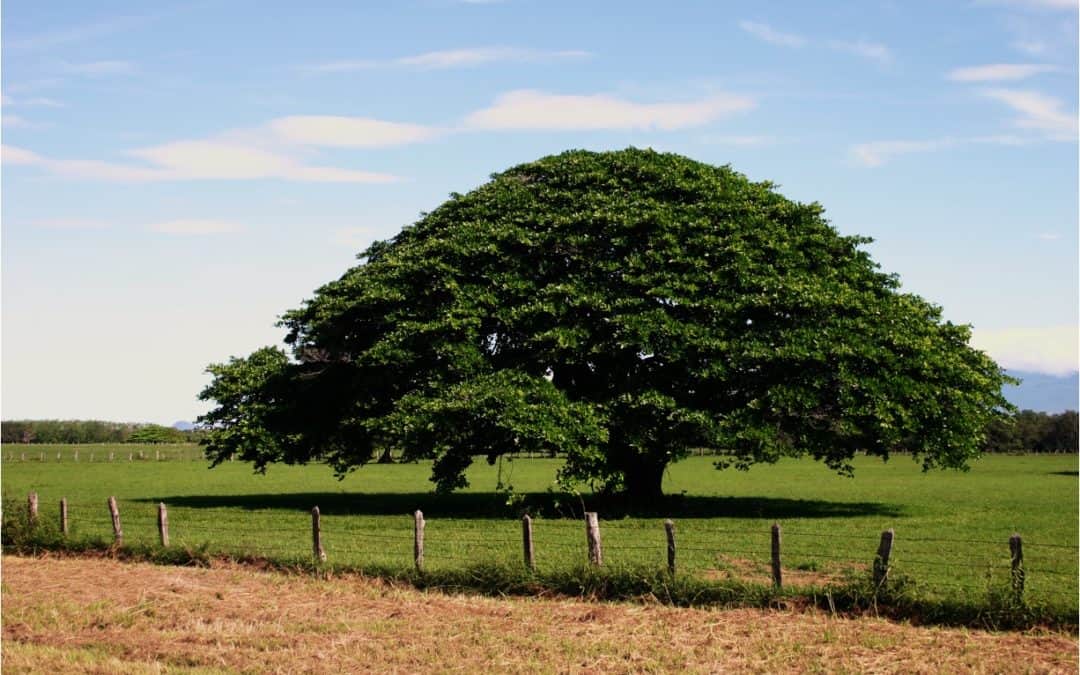Costa Rica is one of the most diverse habitat and wildlife conservation leaders. The country provides a perfect environment for a diverse range of native trees that hold great cultural and ecological significance. The deep-rooted trees of Costa Rica in local culture play an instrumental role in preserving the region’s rich biodiversity. Their presence contributes to the overall beauty and stability of Costa Rica. The country is well known for its abundant natural cloud forests and is home to exotic tree species, making it a prime location for ecotourism. If you plan to visit this amazing destination, we recommend you not miss the spectacular trees of Costa Rica and catch a glimpse of them in the wild.
Árbol de Guanacaste
Arbol de Guanacaste tops the list of our favorite and most popular trees of Costa Rica. Also known as the Elephant ear, it is the national tree of Costa Rica. Its scientific name is “Enterolobium cyclocarpum,” and it belongs to a leguminous family. The flowering evergreen is most known for its spherical crown. It is certainly something to see in person as it is a symbol of stability and strength.
Typically, its height ranges from 82 feet to 164 feet, with the trunk’s diameter ranging from 6 feet to 7 feet. Arbol de Guanacaste can live up to 70 years and produce fruits from January to May. In addition, the white flowers in full bloom can be watched from November to March.
The Walking Palm
Nature never fails to surprise, and the “Walking Palm Tree” in Costa Rica is a testament to that. You will be surprised to learn that the trees have a remarkable ability to move around on their stilt roots. For ages, tourist guides have been mentioning the trees’ unique ability to “walk” due to their complex root system. With a massive height of around 15-20 meters and a diameter of around 16 cm, the trees are not as usual as compared to other trees you find in the wild. It is significantly distinguished from other trees of Costa Rica due to its long, slender, and extended roots. The unique characteristics of the Walking Palm continue to attract nature lovers. So, the next time you go through the rainforest, keep an eye out for any “moving” trees!
Indio Desnudo
Indio Desnudo trees are abundant across farms and secondary forests in Costa Rica. Its bark has rich, intense colors ranging from orange, green, and coffee that falls off in thin slices or sheets. The trees have aromatic leaves and bark, and over the years, it has been used as a natural medicine to cure diseases, including ulcers, diarrhea, and thyroid issues, amongst others.
Matapalo
Matapalo trees’ local name is Strangler Fig, and they are a common sight in Costa Rica. As the trees are commonly found, you may encounter them easily while you are hiking or exploring the rainforest regions. The trees are famous for their cultural importance throughout the region as objects of worship and for several practical uses. It is a pan tropical genus of trees, vines, and shrubs occupying a range of ecological niches, most of which are evergreen. They are characterized by their unique inflorescence and distinctive pollination from wasp species.
Espavel
The Espavel tree is commonly found in the tropical forests of Costa Rica. These trees are mostly found along the banks of the river and streams. With large size, it boasts a height of around 40 meters and diameters of up to 1.5 meters, with a cylindrical trunk and an aromatic sap. Its bark and leaves are primarily used to treat ailments, including skin infections, respiratory issues, and stomach aches. Its edible fruits are often consumed as a natural remedy for diarrhea. Overall, Espavel’s contribution to traditional medicine reflects its deep connection between nature and the community’s well-being in Costa Rican culture.
Almendro
One of the impressive giant trees in the tropical forests of Costa Rica is Almendro. Ecologically, Almendro is considered one of the keystone trees of Costa Rica as it hosts more than a thousand different lifeforms from roots to the top that consume its fruits. It can reach up to 40 meters in height and features graceful rounded crowns. A massive bunch of flowers are produced at the end of the branches after the onset of the rainy season, so within a month or two, the forest canopy is spread with purple flowers. The hardwood is covered by smooth pink to golden bark and bears fruits of around 20 or more per year, weighing 20-25 gms.
With this, we conclude the list of top trees of Costa Rica that you shouldn’t miss on your next trip. As a leader in sustainable forest practices, the country commits to preserving these natural resources while supporting economic growth. Costa Rica has implemented strict regulations to ensure the responsible extraction and replanting of the trees to protect the rainforest and ecosystems.
If you are planning a family vacation or a solo trip soon, get in touch with us to learn more about trips for tree lovers. We will help you in discovering trees in Costa Rica and contribute to a memorable experience.

